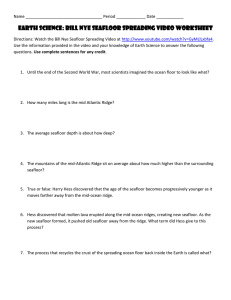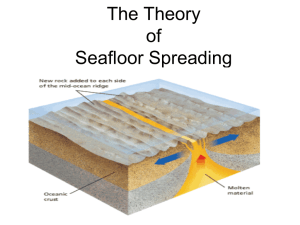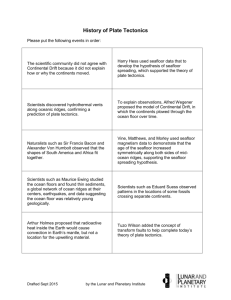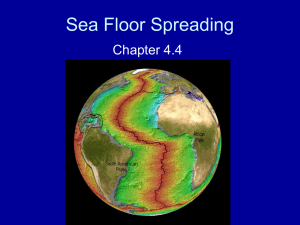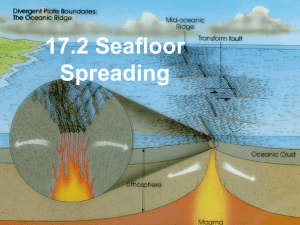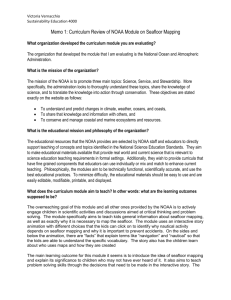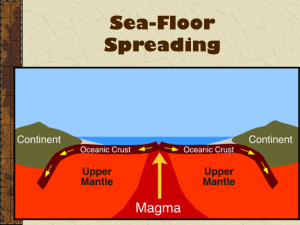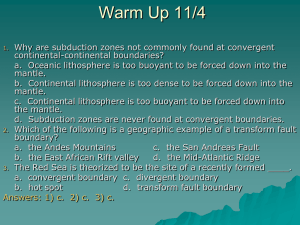3 - Sea Floor Spreading
advertisement
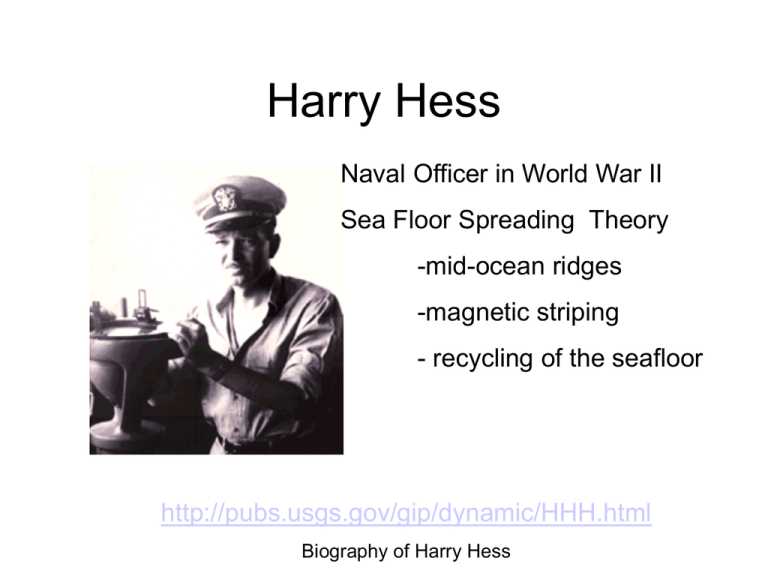
Harry Hess Naval Officer in World War II Sea Floor Spreading Theory -mid-ocean ridges -magnetic striping - recycling of the seafloor http://pubs.usgs.gov/gip/dynamic/HHH.html Biography of Harry Hess Seafloor Spreading Harry Hess 1960s – the theory of seafloor spreading proposed to explain presence of midocean ridge. – SONAR (sound, navigation, and range) used to map the ocean floor – A system of underwater mountain ranges discovered around the world Seafloor Spreading • Questions Hess wanted answers to: – Why is there so little sediment deposited on the ocean floor? If the oceans have existed for at least 4 billion years, as most geologists believed, shouldn’t there be more? – Why are fossils found on the seafloor no more than 180 million years old? Marine fossils in sedimentary rocks on land -- some of which are found high in the Himalayas, over 8,500 m above sea level – are much older. – How do the continents move? Seafloor Spreading • Hess’ reasoning: – Sediment has been accumulating for about 300 million years at most. • Matches time needed for the ocean floor to move from the ridge crest to the ocean trenches, where oceanic crust descends into the trench and is destroyed. – Magma is continually rising along the midoceanic ridges, "recycling" crustal material by creating new oceanic crust. • Recycling of the seafloor explains why the oldest fossils found on the seafloor are no more than about 180 million years old. Seafloor Spreading • Explains how continents moved – Wegener thought the continents must simply "plow" through the ocean floor, critics argued this was physically impossible. – With seafloor spreading, the continents did not have to push through the ocean floor but were carried along as the ocean floor spread from the ridges. Sonar - Echo Sounding Evidence for Seafloor Spreading • molten material - erupting along midocean ridges • magnetic striping - reversals of Earth’s magnetic field is recorded in stripes parallel to the ridges (last was 780,000 years ago) • drilling samples – Glomar Challenger – drilling ship built in 1968, youngest rocks were always found at the midocean ridges What’s goin’ on? • Hot, less dense material below Earth’s crust rises upward to the surface at the mid-ocean ridges. • It then flows sideways, carrying the seafloor away from the ridge. • As the seafloor spreads apart, magma moves up and flows from the cracks, cools, and forms new seafloor. Seafloor Spreading Magnetic Striping Seafloor Spreading & Magnetic Striping 1) Mid-ocean ridge topography with magma chamber below, 2) Magma rises and new ocean plate spreads away from ridge. 3) Magnetic stripes form in igneous rocks containing iron as they move away from ridge. Magnetic Reversals • What is the process? – reversals happen infrequently—on average every 250,000 years – it's been over 700,000 years since the last reversal, and the next one may be currently underway – NOVA Animation of Magnetic Pole Reversals click on “Launch Interactive” Age of Crust Glomar Challenger
